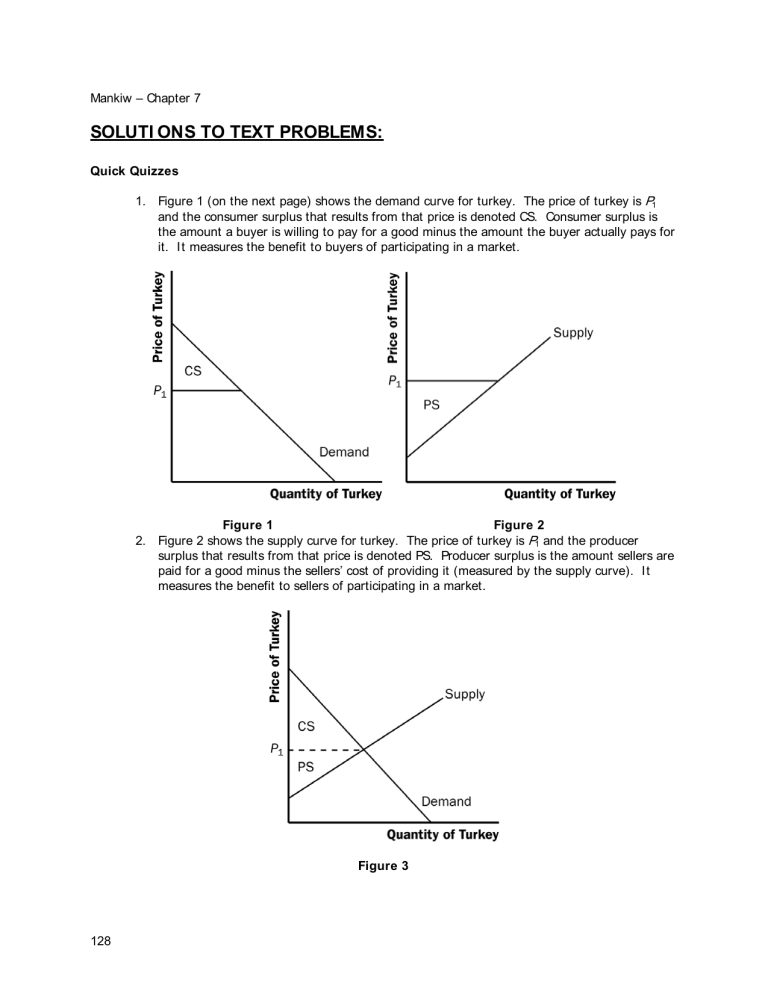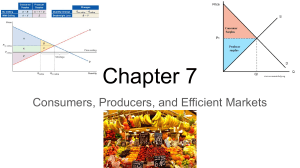
Mankiw – Chapter 7 SOLUTI ONS TO TEXT PROBLEMS: Quick Quizzes 1. Figure 1 (on the next page) shows the demand curve for turkey. The price of turkey is P1 and the consumer surplus that results from that price is denoted CS. Consumer surplus is the amount a buyer is willing to pay for a good minus the amount the buyer actually pays for it. It measures the benefit to buyers of participating in a market. Figure 1 Figure 2 2. Figure 2 shows the supply curve for turkey. The price of turkey is P1 and the producer surplus that results from that price is denoted PS. Producer surplus is the amount sellers are paid for a good minus the sellers’ cost of providing it (measured by the supply curve). It measures the benefit to sellers of participating in a market. Figure 3 128 Chapter 7/ Consumers, Producers, and the Efficiency of Markets ¬ 129 3. Figure 3 shows the supply and demand for turkey. The price of turkey is P1, consumer surplus is CS, and producer surplus is PS. Producing more turkeys than the equilibrium quantity would lower total surplus because the value to the marginal buyer would be lower than the cost to the marginal seller on those additional units. Questions for Review 1. The price a buyer is willing to pay, consumer surplus, and the demand curve are all closely related. The height of the demand curve represents the willingness to pay of the buyers. Consumer surplus is the area below the demand curve and above the price, which equals the price that each buyer is willing to pay minus the price actually paid. 2. Sellers' costs, producer surplus, and the supply curve are all closely related. The height of the supply curve represents the costs of the sellers. Producer surplus is the area below the price and above the supply curve, which equals the price received minus each seller's costs of producing the good. Figure 4 3. Figure 4 shows producer and consumer surplus in a supply-and-demand diagram. 4. An allocation of resources is efficient if it maximizes total surplus, the sum of consumer surplus and producer surplus. But efficiency may not be the only goal of economic policymakers; they may also be concerned about equity⎯the fairness of the distribution of well-being. 5. The invisible hand of the marketplace guides the self-interest of buyers and sellers into promoting general economic well-being. Despite decentralized decision making and selfinterested decision makers, free markets lead to an efficient outcome. 6. Two types of market failure are market power and externalities. Market power may cause market outcomes to be inefficient because firms may cause price and quantity to differ from the levels they would be under perfect competition, which keeps total surplus from being maximized. Externalities are side effects that are not taken into account by buyers and sellers. As a result, the free market does not maximize total surplus. 130 ¬ Chapter 7/ Consumers, Producers, and the Efficiency of Markets Problems and Applications 1. a. Consumer surplus is equal to willingness to pay minus the price paid. Therefore, Melissa’s willingness to pay must be $200 ($120 + $80). b. Her consumer surplus at a price of $90 would be $200 - $90 = $110. c. If the price of an iPod was $250, Melissa would not have purchased one because the price is greater than her willingness to pay. Therefore, she would receive no consumer surplus. 2. If an early freeze in California sours the lemon crop, the supply curve for lemons shifts to the left, as shown in Figure 5. The result is a rise in the price of lemons and a decline in consumer surplus from A + B + C to just A. So consumer surplus declines by the amount B + C. Figure 5 In the market for lemonade, the higher cost of lemons reduces the supply of lemonade, as shown in Figure 6. The result is a rise in the price of lemonade and a decline in consumer surplus from D + E + F to just D, a loss of E + F. Note that an event that affects consumer surplus in one market often has effects on consumer surplus in other markets. Chapter 7/ Consumers, Producers, and the Efficiency of Markets ¬ 131 Figure 6 3. A rise in the demand for French bread leads to an increase in producer surplus in the market for French bread, as shown in Figure 7. The shift of the demand curve leads to an increased price, which increases producer surplus from area A to area A + B + C. Figure 7 The increased quantity of French bread being sold increases the demand for flour, as shown in Figure 8. As a result, the price of flour rises, increasing producer surplus from area D to D + E + F. Note that an event that affects producer surplus in one market leads to effects on producer surplus in related markets. 132 ¬ Chapter 7/ Consumers, Producers, and the Efficiency of Markets Figure 8 4. a. Bert’s demand schedule is: Price More than $7 $5 to $7 $3 to $5 $1 to $3 $1 or less Quantity Demanded 0 1 2 3 4 Bert’s demand curve is shown in Figure 9. Figure 9 b. When the price of a bottle of water is $4, Bert buys two bottles of water. His consumer surplus is shown as area A in the figure. He values his first bottle of water at $7, but pays only $4 for it, so has consumer surplus of $3. He values his second bottle of water Chapter 7/ Consumers, Producers, and the Efficiency of Markets ¬ 133 at $5, but pays only $4 for it, so has consumer surplus of $1. Thus Bert’s total consumer surplus is $3 + $1 = $4, which is the area of A in the figure. c. When the price of a bottle of water falls from $4 to $2, Bert buys three bottles of water, an increase of one. His consumer surplus consists of both areas A and B in the figure, an increase in the amount of area B. He gets consumer surplus of $5 from the first bottle ($7 value minus $2 price), $3 from the second bottle ($5 value minus $2 price), and $1 from the third bottle ($3 value minus $2 price), for a total consumer surplus of $9. Thus consumer surplus rises by $5 (which is the size of area B) when the price of a bottle of water falls from $4 to $2. 5. a. Ernie’s supply schedule for water is: Price More than $7 $5 to $7 $3 to $5 $1 to $3 Less than $1 Quantity Supplied 4 3 2 1 0 Ernie’s supply curve is shown in Figure 10. Figure 10 b. When the price of a bottle of water is $4, Ernie sells two bottles of water. His producer surplus is shown as area A in the figure. He receives $4 for his first bottle of water, but it costs only $1 to produce, so Ernie has producer surplus of $3. He also receives $4 for his second bottle of water, which costs $3 to produce, so he has producer surplus of $1. Thus Ernie’s total producer surplus is $3 + $1 = $4, which is the area of A in the figure. c. When the price of a bottle of water rises from $4 to $6, Ernie sells three bottles of water, an increase of one. His producer surplus consists of both areas A and B in the figure, an increase by the amount of area B. He gets producer surplus of $5 from the first bottle ($6 price minus $1 cost), $3 from the second bottle ($6 price minus $3 cost), and $1 from the third bottle ($6 price minus $5 price), for a total producer surplus of $9. Thus 134 ¬ Chapter 7/ Consumers, Producers, and the Efficiency of Markets producer surplus rises by $5 (which is the size of area B) when the price of a bottle of water rises from $4 to $6. 6. a. From Ernie’s supply schedule and Bert’s demand schedule, the quantity demanded and supplied are: Price $2 $4 $6 Quantity Supplied 1 2 3 Quantity Demanded 3 2 1 Only a price of $4 brings supply and demand into equilibrium, with an equilibrium quantity of two. b. At a price of $4, consumer surplus is $4 and producer surplus is $4, as shown in Problems 3 and 4 above. Total surplus is $4 + $4 = $8. c. If Ernie produced one less bottle, his producer surplus would decline to $3, as shown in Problem 4 above. If Bert consumed one less bottle, his consumer surplus would decline to $3, as shown in Problem 3 above. So total surplus would decline to $3 + $3 = $6. d. If Ernie produced one additional bottle of water, his cost would be $5, but the price is only $4, so his producer surplus would decline by $1. If Bert consumed one additional bottle of water, his value would be $3, but the price is $4, so his consumer surplus would decline by $1. So total surplus declines by $1 + $1 = $2. 7. a. The effect of falling production costs in the market for stereos results in a shift to the right in the supply curve, as shown in Figure 11. As a result, the equilibrium price of stereos declines and the equilibrium quantity increases. Figure 11 b. The decline in the price of stereos increases consumer surplus from area A to A + B + C + D, an increase in the amount B + C + D. Prior to the shift in supply, producer surplus Chapter 7/ Consumers, Producers, and the Efficiency of Markets ¬ 135 was areas B + E (the area above the supply curve and below the price). After the shift in supply, producer surplus is areas E + F + G. So producer surplus changes by the amount F + G – B, which may be positive or negative. The increase in quantity increases producer surplus, while the decline in the price reduces producer surplus. Because consumer surplus rises by B + C + D and producer surplus rises by F + G – B, total surplus rises by C + D + F + G. c. If the supply of stereos is very elastic, then the shift of the supply curve benefits consumers most. To take the most dramatic case, suppose the supply curve were horizontal, as shown in Figure 12. Then there is no producer surplus at all. Consumers capture all the benefits of falling production costs, with consumer surplus rising from area A to area A + B. Figure 12 8. Figure 13 shows supply and demand curves for haircuts. Supply equals demand at a quantity of three haircuts and a price between $4 and $5. Firms A, C, and D should cut the hair of Ellen, Jerry, and Phil. Oprah’s willingness to pay is too low and firm B’s costs are too high, so they do not participate. The maximum total surplus is the area between the demand and supply curves, which totals $11 ($8 value minus $2 cost for the first haircut, plus $7 value minus $3 cost for the second, plus $5 value minus $4 cost for the third). 136 ¬ Chapter 7/ Consumers, Producers, and the Efficiency of Markets $8 Ellen Jerry 7 Price of Haircuts 6 Phil 5 4 C 3 2 B A Oprah D 1 1 2 3 4 Quantity of Haircuts Figure 13 9. a. The effect of falling production costs in the market for computers results in a shift to the right in the supply curve, as shown in Figure 14. As a result, the equilibrium price of computers declines and the equilibrium quantity increases. The decline in the price of computers increases consumer surplus from area A to A + B + C + D, an increase in the amount B + C + D. Figure 14 Prior to the shift in supply, producer surplus was areas B + E (the area above the supply curve and below the price). After the shift in supply, producer surplus is areas E + F + G. So producer surplus changes by the amount F + G – B, which may be positive or negative. The increase in quantity increases producer surplus, while the decline in the price reduces producer surplus. Because consumer surplus rises by B + C + D and producer surplus rises by F + G – B, total surplus rises by C + D + F + G. Chapter 7/ Consumers, Producers, and the Efficiency of Markets ¬ 137 b. Because adding machines are substitutes for computers, the decline in the price of computers means that people substitute computers for adding machines, shifting the demand for adding machines to the left, as shown in Figure 15. The result is a decline in both the equilibrium price and equilibrium quantity of adding machines. Consumer surplus in the adding-machine market changes from area A + B to A + C, a net change of C – B. Producer surplus changes from area C + D + E to area E, a net loss of C + D. Adding-machine producers are sad about technological advances in computers because their producer surplus declines. Figure 15 c. Because software and computers are complements, the decline in the price and increase in the quantity of computers means that the demand for software increases, shifting the demand for software to the right, as shown in Figure 16. The result is an increase in both the price and quantity of software. Consumer surplus in the software market changes from B + C to A + B, a net change of A – C. Producer surplus changes from E to C + D + E, an increase of C + D, so software producers should be happy about the technological progress in computers. 138 ¬ Chapter 7/ Consumers, Producers, and the Efficiency of Markets Figure 16 d. Yes, this analysis helps explain why Bill Gates is one the world’s richest people, because his company produces a lot of software that is a complement with computers and there has been tremendous technological advance in computers. 10. a. Figure 17 illustrates the demand for medical care. If each procedure has a price of $100, quantity demanded will be Q1 procedures. Figure 17 b. If consumers pay only $20 per procedure, the quantity demanded will be Q2 procedures. Because the cost to society is $100, the number of procedures performed is too large to maximize total surplus. The quantity that maximizes total surplus is Q1 procedures, which is less than Q2. c. The use of medical care is excessive in the sense that consumers get procedures whose value is less than the cost of producing them. As a result, the economy’s total surplus is reduced. d. To prevent this excessive use, the consumer must bear the marginal cost of the procedure. But this would require eliminating insurance. Another possibility would be that the insurance company, which pays most of the marginal cost of the procedure ($80, in this case) could decide whether the procedure should be performed. But the insurance company does not get the benefits of the procedure, so its decisions may not reflect the value to the consumer. 11. a. The supply and demand curves are shown in Figure 18. The equilibrium price and quantity are found by equating quantity demanded and quantity supplied: 4P – 80 = 100 – 2P 6P = 180 P = $3.00 Q = 40 Chapter 7/ Consumers, Producers, and the Efficiency of Markets ¬ 139 The equilibrium price is $3 per bushel and the equilibrium quantity is 40 bushels. Price of Broccoli 50 S 30 20 D 40 Quantity of Broccoli (bushels) Figure 18 b. At the market equilibrium, consumer surplus is equal to (0.5)($20)(40) = $400. Producer surplus at market equilibrium is (0.5)($10)(40) = $200. Therefore, total surplus is $400 + $200 = $600. c. If a dictator banned the sale of broccoli, producer and consumer surplus would both fall to $0. Buyers would be harmed more than sellers would because the decline in consumer surplus would be greater than the decline in producer surplus.





